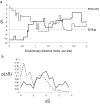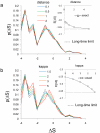Statistical tests for natural selection on regulatory regions based on the strength of transcription factor binding sites
- PMID: 19995462
- PMCID: PMC2800119
- DOI: 10.1186/1471-2148-9-286
Statistical tests for natural selection on regulatory regions based on the strength of transcription factor binding sites
Abstract
Background: Although cis-regulatory changes play an important role in evolution, it remains difficult to establish the contribution of natural selection to regulatory differences between species. For protein coding regions, powerful tests of natural selection have been developed based on comparisons of synonymous and non-synonymous substitutions, and analogous tests for regulatory regions would be of great utility.
Results: Here, tests for natural selection on regulatory regions are proposed based on nucleotide substitutions that occur in characterized transcription factor binding sites (an important type functional element within regulatory regions). In the absence of selection, these substitutions will tend to reduce the strength of existing binding sites. On the other hand, purifying selection will act to preserve the binding sites in regulatory regions, while positive selection can act to create or destroy binding sites, as well as change their strength. Using standard models of binding site strength and molecular evolution in the absence of selection, this intuition can be used to develop statistical tests for natural selection. Application of these tests to two well-characterized regulatory regions in Drosophila provides evidence for purifying selection.
Conclusion: This demonstrates that it is possible to develop tests for selection on regulatory regions based on the specific functional constrains on these sequences.
Figures




Similar articles
-
Natural selection in a population of Drosophila melanogaster explained by changes in gene expression caused by sequence variation in core promoter regions.BMC Evol Biol. 2016 Feb 9;16:35. doi: 10.1186/s12862-016-0606-3. BMC Evol Biol. 2016. PMID: 26860869 Free PMC article.
-
Does positive selection drive transcription factor binding site turnover? A test with Drosophila cis-regulatory modules.PLoS Genet. 2011 Apr;7(4):e1002053. doi: 10.1371/journal.pgen.1002053. Epub 2011 Apr 28. PLoS Genet. 2011. PMID: 21572512 Free PMC article.
-
In silico evolution of the Drosophila gap gene regulatory sequence under elevated mutational pressure.BMC Evol Biol. 2017 Feb 7;17(Suppl 1):4. doi: 10.1186/s12862-016-0866-y. BMC Evol Biol. 2017. PMID: 28251865 Free PMC article.
-
Mutation pressure, natural selection, and the evolution of base composition in Drosophila.Genetica. 1998;102-103(1-6):49-60. Genetica. 1998. PMID: 9720271 Review.
-
Extensive purifying selection acting on synonymous sites in HIV-1 Group M sequences.Virol J. 2008 Dec 23;5:160. doi: 10.1186/1743-422X-5-160. Virol J. 2008. PMID: 19105834 Free PMC article. Review.
Cited by
-
What does it take to evolve an enhancer? A simulation-based study of factors influencing the emergence of combinatorial regulation.Genome Biol Evol. 2015 May 7;7(6):1415-31. doi: 10.1093/gbe/evv080. Genome Biol Evol. 2015. PMID: 25956793 Free PMC article.
-
Natural selection in a population of Drosophila melanogaster explained by changes in gene expression caused by sequence variation in core promoter regions.BMC Evol Biol. 2016 Feb 9;16:35. doi: 10.1186/s12862-016-0606-3. BMC Evol Biol. 2016. PMID: 26860869 Free PMC article.
-
Cis-regulatory elements and human evolution.Curr Opin Genet Dev. 2014 Dec;29:81-9. doi: 10.1016/j.gde.2014.08.011. Epub 2014 Sep 16. Curr Opin Genet Dev. 2014. PMID: 25218861 Free PMC article. Review.
-
Probing mechanical selection in diverse eukaryotic genomes through accurate prediction of 3D DNA mechanics.bioRxiv [Preprint]. 2024 Dec 23:2024.12.22.629997. doi: 10.1101/2024.12.22.629997. bioRxiv. 2024. PMID: 39763889 Free PMC article. Preprint.
-
Evidence that purifying selection acts on promoter sequences.Genetics. 2011 Nov;189(3):1121-6. doi: 10.1534/genetics.111.133637. Epub 2011 Sep 6. Genetics. 2011. PMID: 21900262 Free PMC article.
References
-
- Dermitzakis ET, Clark AG. Evolution of transcription factor binding sites in Mammalian gene regulatory regions: conservation and turnover. Molecular Biology and Evolution. 2002;19(7):1114–21. - PubMed
Publication types
MeSH terms
Substances
LinkOut - more resources
Full Text Sources
Molecular Biology Databases

